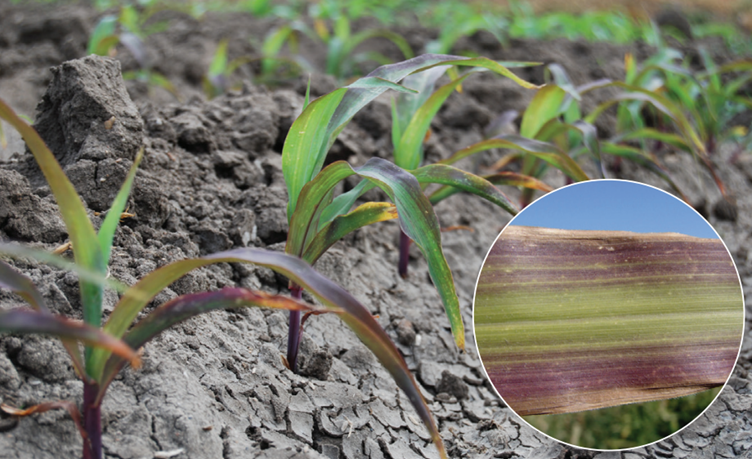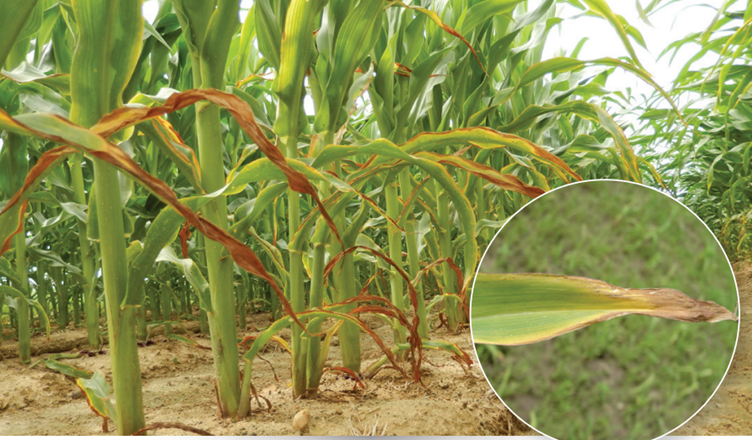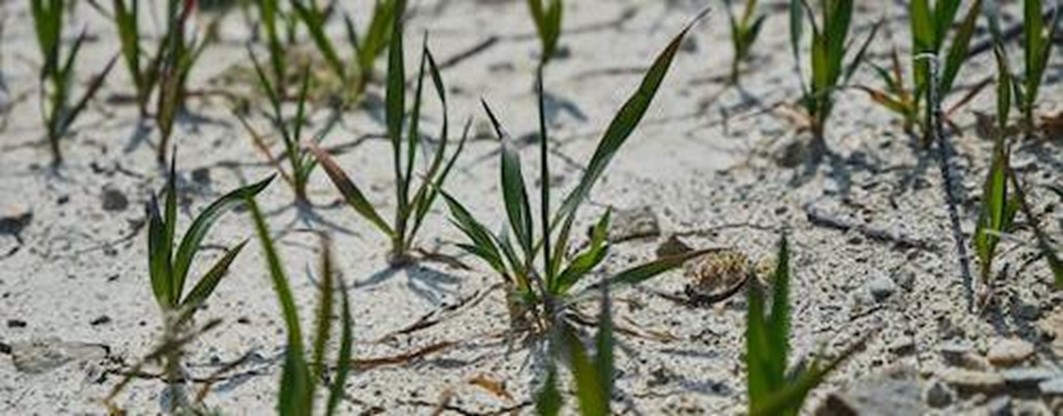The importance and management of Phosphorus (P) and Potassium (K) in plant production
Phosphorus
Phosphorus (the element P, often called phosphate, e.g., HPO42-). Phosphates are the naturally occurring form of P in minerals and solutions and with mainly H2PO4- in acidic soil solutions and mainly H2PO4– in neutral and alkaline ones. In “chemical” fertilizers, phosphates are made directly water soluble with common, nutrient-rich acids containing N, P, or S. If needed, P can be remobilized from old to young leaves, so deficiency symptoms are first seen on old leaves. Figure 1.

Figure 1. Phosphorus (P) deficiency e.g., in maize, starts at the older leaves and can cause small tops with purple colours. Permission: Maize -Crop Scout Pocket Guide. African Plant Nutrition Institute, APNI.net.
Phosphorus (P) is taken up in about 10 % of the amount of nitrogen (N) in healthy plants (with considerable variations) and lower. Potassium (K) is taken up in intermediary amounts. N, P, and K are called macronutrients or primary nutrients because they are needed in higher amounts than secondary (‘meso’) nutrients and micronutrients.
P is often a limiting factor for young plants because P is needed in the highest concentration in young parts. P and requires long (not deep) roots to take enough up in good soil conditions. Long root hairs and mycorrhizal fungi help as root extensions. P has low mobility and concentration in soil water and should usually be mixed into the soil near seeds.
Mixing P fertilizer with only a minor part of the soil (placement) also reduces the big challenge of it binding too hard to soil for plants or fungi can take it up. Red or yellow clay soils and soils with extreme pH values are particularly problematic, as well as too dry, wet, cold, or hot soil.
Due to the low water solubility, concentration, and mobility of phosphate, it is not easily washed (leached) deep into the soil after application. Therefore, soil conservation is important for keeping nutrients and avoiding pollution of fresh and coastal waters. In recent decades, leaching of phosphates (and pesticides) has been documented where macropores are left by the activity of big worms at the soil or decayed roots, and a subsurface drainage system exists – e.g., in much of Denmark. These systems lead water into streams. In some places, P and not N are the limiting (determining) nutrients for plants that can grow too much in water (eutrophication) and suddenly rot using all oxygen.
Likewise, deep roots can take up some nutrients from the subsoil – at least if it contains minerals that can still contain minerals that can be broken down (weatherable minerals).
These have dark or shiny parts but not the red (or yellow) parts expected in the humid tropics. Red and yellow clays in the tropics can also bind P strongly, particularly at acidic pH. However, undocumented drawings and claims often exaggerate the benefits of liming acidic soil for P-availability. This is because phosphate is not simply held as most other negative ions like nitrate. Instead, specific chemical bonds form between phosphate and iron- or aluminium hydroxides. Therefore, the effect of making the charge of the clay particles positive by removing H+ by liming is much weaker than on other ions like reducing the solubility of positive ions like root toxic aluminium (Al3+ or micronutrients other than Molybdate-anions). Often, even the silicate oxide (SiO2), the quarts of sand, is made of or washed out of old soils in the humid tropics. However, some hills and areas have more recent volcanic soils that can be rich in nutrients. These areas can contain more P and other nutrients, but recent volcanic ash soil also tends to bind P strongly in unavailable forms due to the very high phosphate sorption capacity of such ash soil (Andosols).
Potassium (K)
Potassium (K, K+) is called ‘Kalium’ in German (not Calcium). It is moderately mobile in soils. Applying K is often important, particularly for the control of transpiration, structure, and starch and fibre formation. K-deficient plants tend to wilt at the edges of mature leaves (Figure 2).

Figure 2. Potassium (K) deficiency e.g. in maize starting at the older leaves and yellowing or wilting leaves from the edge. Permission: Maize – Crop Scout Pocket Guide. African Plant Nutrition Institute, APNI.net.
NPK fertilizers may be the most common for temperate areas, but in the humid tropics, K in fertilizer is often not needed yet for grain crops and pulses, but often needed for root or oil crops, at least where N P fertilizer has been used. Some sandy or old tropical soils are low in all nutrients a few years after a forest has been cleared – e.g. in Brazil.
K is the nutrient taken up in the second highest amount, the chemistry is relatively simple, and it is not a direct cause of algae and other plants in water getting more nutrients limiting their growth, unlike N or P. It is no direct problem in groundwater either.
However, a research review was surprisingly critical to the widespread use of K in fertilizers, at least in industrialized, temperate countries. It highlighted that soil test results varied much over a brief time because it was hard to determine which fraction of the total K content was planted available. Likewise, most included trials did not show a yield response (to application in a single season). Maintaining the K-availability can still make sense to maintain soil fertility yields before K deficiency gives significant yield reduction. However, in some places, it increases year by year, even if it is high enough. Some K-fertilizer often reduces yields due to their content of chloride (e.g., KCl) and even table salt (sodium chloride, NaCl).[1]
Cl– is very soluble and can be leached together with Ca2+ by balancing the electrical charge. Likewise, K+ ions can also balance nitrate (NO3–), so it is leached more. Less nitrate can give shorter and lighter crops less likely to fall (lodge), and more strength from high K-uptake may not always be the real reason. K is often believed to improve crop quality, but it may increase the starch content, and potatoes uptake of more unhealthy fat when fried. People need enough potassium – but not too much and, in general, in fewer amounts than Sodium, which many people, however, get too much of.
References:
[1] Khan S A, Mulvaney R L, Ellsworth T R (2014): The potassium paradox: Implications for soil fertility, crop production and human health. Renewable Agriculture and Food Systems 29, 3 – 27. https://www.cambridge.org/core/journals/renewable-agriculture-and-food-systems/article/potassium-paradox-implications-for-soil-fertility-crop-production-and-human-health/2C9ADE6C6B44EB23BAA7AE6CD953E085
More reading:
Fertilizer Industry Handbook 2022 (yara.com)
Reetz H F (2016): Fertilizers and their Efficient Use. IFA, Paris, France, May 2016 Library (fertilizer.org)
Haynes R, Naidu, R (1988): Influence of lime, fertilizer and manure applications on soil organic matter content and soil physical conditions: a review. Nutrient Cycling in Agroecosystems 51, 123–137. https://doi.org/10.1023/A:1009738307837
Sustainable Plant Nutrient Management (SPNM): An overview
Sustainable Nutrient management: Introduction to concept, strategies, and principles
Nutrient conservation and cycling
Mineral fertilizers (including ash) and sustainability
Biological Nitrogen Fixation and seeding Legumes for Soil Fertility
The importance and management of Phosphorus (P) and Potassium (K) in plant production
Ion charges and secondary (=meso) nutrients: Calcium, Magnesium and Sulphur
How important are the Micronutrients for plants
Soil and plant analysis and field observations
When are approaches to Plant Nutrient Management actually Sustainable?









































































